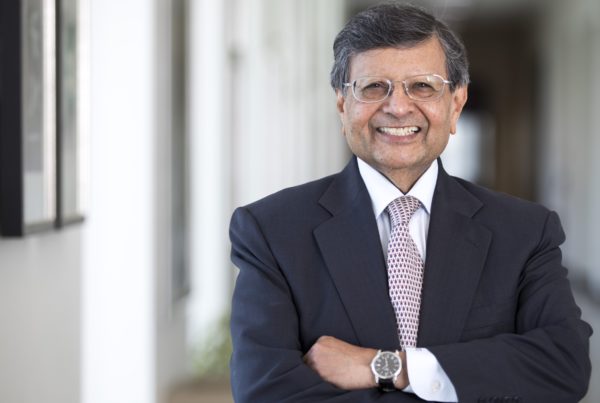Published: Nov 08, 2006 in Knowledge@Emory
On October 27 the largest IPO in history, a $21.9 billion offering by the Industrial & Commercial Bank of China (ICBC), took place in Hong Kong. That might seem unsurprising – after all, Hong Kong is part of China – but Emory University professors say that it’s not something that would have happened even two or three years ago.
ICBC’s floatation in Hong Kong is just the latest example of a more general trend that observers of the global capital markets have noted: increasingly, companies looking to take their companies public aren’t turning to the U.S. exchanges first. Many are going to London, or to exchanges in their home countries.
This wasn’t always the case. Until recently, the ability to raise huge amounts of capital through an initial public offering was seen as a key advantage of the U.S. economy over most of the world. In 1996 – years before the Silicon Valley dotcom boom reached its height — 60 percent of the world’s IPOs were made in America. Yet by 2005, that number had shrunk to less than 20 percent, according to a report by the Public Company Accounting Oversight Board.
Three reasons are generally offered for this rapid shift. First, some observers believe that Sarbanes-Oxley regulations are scaring new companies away from the U.S. Others say that the world economy is changing, and because the U.S. is becoming less of a center of innovation and growth than was once the case, it should come as no surprise that IPOs are also growing elsewhere. Finally, a third group believe that part of this shift is exaggerated just now by a temporary downturn in American enthusiasm for homegrown IPOs — an extended hangover from the exuberance of the dotcom days.
Who’s right? Emory University and its Goizueta Business School faculty see points in favor of each of these three arguments. Ultimately, faculty members say, there may be several reasons the U.S. has lost its IPO mojo.
Sarbanes-Oxley
In a global market where billions flow between countries at the push of a button, some observers say that fear of regulations mandated since the market crash of 2000 has driven many IPO candidates away from the U.S. and toward more lightly-regulated stock exchanges.
Not so long ago, Nasdaq was the hottest market for IPOs in the world. In 2000, Nasdaq had 355 deals that raised a whopping $47.6 billion. The second most popular home for young companies, the London Stock Exchange’s Alternative Investment Market (AIM), had only 157 deals, which raised $1.9 billion. Now the tables have turned. This year, through Sept. 1, 2006, there were 169 new entrants on the AIM, but only 69 on Nasdaq. And although AIM exchange’s IPOs were smaller deals, raising an average of $58 million to Nasdaq’s $106 million, AIM has still raised over $9.7 billion this year to Nasdaq’s $7.3 billion, according to statistics of Sander Morris Harris, an investment bank.
William J. Carney, a professor of corporate law at Emory’s School of Law, agrees with those who say young companies are choosing either to stay private or to list on the AIM market because it can enable them to avoid the expensive reporting requirements of Sarbanes-Oxley.
Although the Securities and Exchange Commission keeps postponing the date when small public companies will actually have to make all those filings, many companies fear that it will be expensive, Carney says.
Compliance with Sarbanes-Oxley costs a minimum of several hundred thousand dollars a year, adds Carney. “In some cases, you have to put in new accounting software, sit down with your accounting firm and think about what areas the accountants are going to worry about — and then you have to do it annually,” he explains.
Narasimhan Jegadeesh, a professor of finance at Goizueta, agrees that Sarbanes has had adversely affected the U.S. IPO market. “Clearly, Sarbanes-Oxley, has made private capital relatively more attractive, particularly for smaller firms,”
Global growth
Other observers believe that the end of U.S. domination of the world IPO market is partly due to the fact that many other countries, from Eastern Europe to India to China to Brazil, are growing more rapidly than the U.S.
Over the past decade, high single digit and even double digit growth in some emerging markets has led to some profound changes in the global economic atlas. In purchasing power parity terms, the European Union is now the largest economy on earth, with a gross domestic product (GDP) of $12.4 trillion, $200 billion more than the U.S. China is the third-largest economy in the world, with a $9.4 trillion GDP, followed directly by Japan ($3.9 trillion) and India ($3.6 trillion), according to International Monetary Fund statistics. The picture was quite different ten years ago. In 1996, the U.S. GDP stood at $7.7 trillion, while China, for example, produced the equivalent of $3.6 trillion, and India $1.8 trillion.
And IPOs seem to be following this trend. One recent report by Ernst & Young noted that of the 20 IPOs worldwide that raised more than $1 billion in 2005, only one was for a U.S. company. The same report noted that although the U.S. is still the single largest IPO market in 2005, with $33 billion raised, the American share amounted to only 20% of the global proceeds. In terms of raw numbers of transactions too, the U.S. is now just one among many players: 631 companies going public in Asia in 2005, 349 in Europe, and 285 in North America.
Some Goizueta professors are persuaded by the global growth argument. A number of these IPOs are due to the privatization of state-owned firms in China and India, according to Jegadeesh, who studies global capital flows. In those countries, many state-owned firms have been privatized in recent years as part of a larger transition toward a more market-driven economy.
Other professors see the growth of an entrepreneurial class in countries that were formerly communist, such as Russia and China, or socialist, such as India, as a major factor behind the growth in demand for IPOs.
“More and more private sector entrepreneurs are allowed to be in business in countries like China where entrepreneurship was once not allowed,” explains Jagdish Sheth, a professor of marketing at Goizueta and corporate strategist.
It takes time for a business to grow. In India, many of the businesses going public today were started in the early to mid 90s, he says. Now, these family-run businesses are reaching a size where they need much more capital to expand and compete, both domestically and globally. Sheth notes that this money is not only being used for operations, but acquisitions: The Tata Group, for instance, recently raised money in an IPO that will help that Indian steelmaker keep up with Mittal, an Indian steel company that is already trying to grow by acquiring steel companies in France and other advanced economies.
But why are companies like ICBC and Tata staying home to raise money? The short answer may well be: because they can. Although as recently as two or three years ago, companies based in emerging markets would turn to London or New York for large amounts of capital, they no longer need to travel quite so far, contends Jegadeesh.
Dotcom discouragement
As the ICBC deal demonstrates, there is now enough money and regulatory infrastructure in many of these emerging market stock exchanges to sustain even large IPOs, according to Jegadeesh. Without the need to travel to find capital, as Jegadeesh notes in a paper just published in the Journal of Financial Economics, that looked at patterns in global capital formation, companies tend to try to raise money as near their home base as possible.
A third reason for the relative dearth of American IPOs stems from some leftover ill-will among investors from the days of the Internet bubble. At that time, new companies were being floated faster, it turned out, than they could actually be built.
Benn Konsynski, a professor of decision and information analysis who studies technology development, says one shouldn’t read too much into the current downturn, and instead see it as a kind of after-effect of the dotcom boom – which is already turning around.
Goizueta’s Sheth agrees and in spite of his belief in the strength of the trend toward growth in emerging markets, he also sees the downturn as “a blip,” due in part to a reaction from those earlier good times, and to a deliberate tightening of listing requirements by Nasdaq.
For Konsynski, a futurist who is accustomed to predicting patterns before they become trends, such market irregularities are merely a sign of entrepreneurs expanding their options. Instead of going public, Konsynski says, companies looking for more capital are turning either toward private equity financing or toward the possibility of being acquired by a larger company.
Konsynski doesn’t expect this trend to have any negative repercussions on the development of those businesses, as long as private equity money remains plentiful. Others are not so sure. Jegadeesh believes that because this trend toward private equity is driven by regulatory costs of going public, it may put some early stage U.S. firms at a disadvantage. Private equity or venture capital money – capital that is typically provided in exchange for a share of the company – tends to be much more expensive than public equity financing, Jegadeesh says, and more expensive financing translates into less money for investment.
So will investors in American IPOs ever make a comeback? While most Emory experts agree with Konsynski that there are cyclical factors behind the current downturn, Jegadeesh and Sheth also believe that emerging market growth will continue to drive the issuance of increasing numbers of IPOs outside the U.S.
Regulatory issues may also continue to dog the market. According to Carney, even if smaller companies are ultimately exempted from Sarbanes-Oxley, Nasdaq and other U.S. markets won’t immediately regain the share of the market they have lost to the UK’s AIM exchange.




